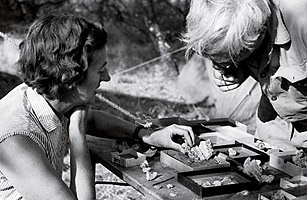
Mary and Louis Leakey examine fossils they found in Tanzania.
July 17, 1959
My father was ill that morning, so my mother set out alone in the Land Rover, accompanied by her two Dalmatians. She spent the morning crawling along the slope of the nearby gorge but found very little until just before noon, when she noticed a scrap of enormously thick bone protruding from beneath the surface. She instantly realized that it was part of a hominid skull — and that two teeth were embedded in the rock just above it. Elated, she drove back to camp to tell my father Louis. As he remembered it, she rushed in crying, "I've got him! I've got him! I've got him!" What my mother Mary had discovered were the fragments of a fossil skull that was later to be named Zinjanthropus boisei. It was to rivet world attention on the Olduvai Gorge in Tanganyika (now Tanzania) and on the work of my parents.
I arrived at Olduvai a day after the skull was found. My parents' simple camp seemed to radiate the excitement of the moment, and I don't recall ever seeing my parents in such high spirits. The skull that my mother recovered was in many pieces, but she and my father were able to piece it back together. It was the first really significant find at Olduvai; indeed, it was the only well-preserved fossil hominid to have been found outside South Africa, several thousand miles to the south.
Unlike the South African sites, which lacked distinct geological layers, Olduvai offered a chance to get some real ages for the fossils. Using a method known as potassium-argon dating, Zinjanthropus was determined to be 1.75 million years old. At the time, this was staggering. It almost tripled the skull's estimated age, which had been obtained by geological interpretation. It stretched back our evolutionary perspective. Since that day, hundreds of hominid fossils have been discovered across a wide range of African sites. Many of these are undoubtedly of greater scientific interest than the 1959 find, but in my opinion no other discovery has had the impact on this field of human inquiry. The dating of the Olduvai strata began a new chapter in our understanding of human origins: it added the dimension of real time to evolution.
Leakey, now an environmentalist, is working on a major international wildlife-conservation fund for East Africa